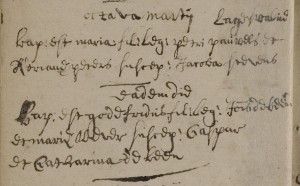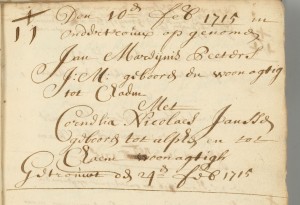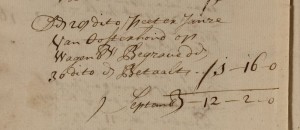For the seventeenth and eighteenth century, church records provide the most complete records for genealogical research. The church recorded the baptisms, marriages and burials of their members. Many of those records have survived to this day.
History
Since the early days of Christianity, people have been baptized, married and burried by the church. The church has not always kept records of these events. In the Netherlands, the oldest surviving church records date back to the sixteenth century.
For most regions, church records start in the seventeenth century. In general, church records start earlier in the southern and western parts of the Netherlands than they do in the nothern and eastern parts.
When the civil registration was introduced, churches were required to hand over their registrations. To this day, most of the church registrations can be found in the provincial archives because of this decision.
The most important church records are:
In Dutch these are called Doopboeken, Trouwboeken and Begraafboeken. They are often referred to using the acronym DTB.
Catholic church records were usually kept in Latin whereas Dutch reformed church records were usually kept in Dutch.
Baptismal records

Baptismal records record the baptism of a child. For most religions, the baptism took place within two weeks of the birth. An exception is the baptist church, which only baptized adults.
The baptismal record lists the following information:
- The gender and name of the child(ren)
- The date of baptism, sometimes the date of birth as well
- The names of the parents of the child. Some lazy record keepers only list the father.
- Usually, the names of the witnesses
The baptism had to be witnessed by at least two people. In Catholic families, these were the godparents.
In the case of children born out of wedlock, this was noted as well. The term “hoerkind” (child of a whore) is used sometimes to denote these children. This does not mean the mother was a prostitute, it only reflects what the record keeper thought of her morals. In Catholic records, the words “illegitimus” or “illegitima”, sometimes shortened to “illeg:” means the child is born out of wedlock.
Marriage records
From 1648 until 1795, the Catholic marriage was not considered a legal marriage but Dutch reformed marriages were. This means most catholics married twice: once before the Catholic church and once for the law. The legal marriage could either be before the court or in the Dutch Reformed church. It often pays to check both records since very often different details are noted in the different records.
Compared to the later civil registration marriage records, church marriage records are pretty short. Depending on the record keeper, sometimes the parents were noted, sometimes not. The same goes for previous spouses: sometimes it was only mentioned that a person was a widow but mostly the name of the previous spouse was mentioned as well.
At a minimum you can find the following information:
- Name and place of residence of the groom, often the place of birth as well
- Name and place of residence of the bride, often the place of birth as well
- Marrital status of bride and groom
- Date of the wedding and/or the publication of the banns
To make sure there were no impediments, a marriage was announced for three consecutive Sundays before the marriage was closed. Usually the marriage was writted down when the couple first registered for the publication of the banns. After the announcements went unhindered, the actual marriage took place. Most of the time, the marriage date is then written behind the original registration. This means you have to be careful when you find a date in a marriage record: is it the date of the marriage or that of the publication of the banns?
The announcements had to take place in both the places or residence of the bride and groom. This gives you an extra opportunity to find additional information. If the person had only lived there for a short while, the marriage had to be announced in the previous town as well. In every town where the marriage was announced, it was registered as well. It is not uncommon to find three or four different marriage records for one couple!
Burial records
Burial records are the most difficult church records to work with. They often contain very little information. Most burial records only record the name of the deceased. Sometimes not even that is written down, only entries like “the old woman on the Woordes farm”, “Jansens maid”, etc. Descriptions that probably made perfect sense to the locals back then, but very hard to figure out today.
Some entries are more helpful, and list the names of the spouses or the address and whether they left any children behind. Most burial records record only the burial date, but some include the death date as well.
Where to find church records?
Church records can be found on the websites of archives, or in national portals like Open Archives, WieWasWie, or Archieven.nl. FamilySearch also has many scans of church records, but many are unindexed. You can search the catalog for the name of the town.
Dutch Genealogy source score
 Amount of information about births, marriages, deaths
Amount of information about births, marriages, deaths
 Amount of background information about your ancestors
Amount of background information about your ancestors
 Online availability of scans
Online availability of scans
 Online availability of indexes or transcriptions
Online availability of indexes or transcriptions
 Easy to understand if you don’t know Dutch
Easy to understand if you don’t know Dutch




Hello, I’m a grandson of the late Reverend Ezra Shumba the first African reverend to be ordained in Zimbabwe where he served from 1951 to 1978. Can you help me find his records
My ancestor Domingo Madaras or his parents came to Holland by 1620 & then came to America by 1650 to VA- I am interested in finding out about HOlland in the 1600’s. We think he came on a ship whose captain was Meinort Doodes. They both settled eventually in Middlesex Co. VA.
Bev
My ancestor was Jan Johannes Jansen, born 1766 in West Friesland and died on 3/7/1850 in South Africa. I’m looking for his parents ‘ names and where they lived. Can you help me?
https://www.wikitree.com/wiki/Jansen-2215
Look on Wiki tree and on Family search
I’ve come across an unusual abbreviation in the baptismal record of Cornelia de Waal:
“2l” (lower case L). I’ve tried but cannot find the meaning of this abbreviation. My best efforts at a full transcription in Dutch- [with an effort at translation to English] – is as follows:
geb. [birth] 2 Apr 1792
ged. [baptism] 8 Apr 1792
Yr [Groom]: Jan de Waal
Mr [Bride]: Pieternella Huisoon
De naam van der Oudster [the name of the oldest] der 2l. [????] Isaac
~~~~~~~~~~~~de jongste [ the youngest] ~~~~~~~~~~~~~~~~ Cornelia.
[ the lines and the positioning iare the same in the record with oudster above jongste.
I haven’t pinned down the other children for Jan and Pieternella yet. Isaac’s baptism is linked to the same record, so he is of course their son, but are Cornelia and Isaac twins? There is only one birth date and one baptismal date given. Though I have another set of twins born [earlier] to a different set of parents, they have separate baptismal records. And no record has anything stating either is a multiple birth…